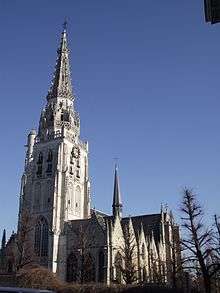Anderlecht
| Anderlecht | |||
|---|---|---|---|
| Municipality | |||
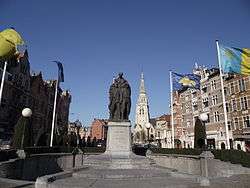 Place de la Vaillance in Anderlecht | |||
| |||
 Anderlecht Location in Belgium
Anderlecht municipality in the Brussels-Capital Region 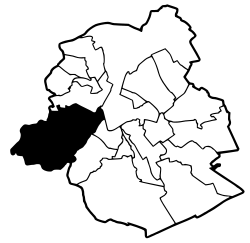 | |||
| Coordinates: 50°50′N 04°20′E / 50.833°N 4.333°ECoordinates: 50°50′N 04°20′E / 50.833°N 4.333°E | |||
| Country | Belgium | ||
| Community |
Flemish Community French Community | ||
| Region | Brussels | ||
| Arrondissement | Brussels | ||
| Government | |||
| • Mayor | Eric Tomas (PS) | ||
| • Governing party/ies | LB - PS-SP.A-CDH | ||
| Area | |||
| • Total | 17.74 km2 (6.85 sq mi) | ||
| Population (1 January 2017)[1] | |||
| • Total | 118,241 | ||
| • Density | 6,700/km2 (17,000/sq mi) | ||
| Postal codes | 1070 | ||
| Area codes | 02 | ||
| Website | www.anderlecht.be | ||
Anderlecht (Dutch pronunciation: [ˈɑndərlɛxt]; French pronunciation: [ɑ̃dɛʁlɛkt]) is one of the nineteen municipalities of the Brussels-Capital Region. Located in the southwest of the city, it is bordered by the City of Brussels, Dilbeek, Forest, Molenbeek-Saint-Jean, Saint-Gilles and Sint-Pieters-Leeuw. There are several historically and architecturally distinct districts within the Anderlecht municipality. In common with all the Brussels municipalities, it is legally bilingual (French–Dutch).
On 1 February 2015, the municipality had a population of around 118,414. The total area is 17.74 km² which gives a population density of 6,610 inhabitants per km².
History
Origins and medieval times
The first traces of human activity on the right bank of the Senne date from the Stone Age and Bronze Age. The remnants of a Roman villa and of a Frankish necropolis were also found on the territory of Anderlecht. The first mention of the name Anderlecht, however, dates only from 1047 under the forms Anrelech, then Andrelet (1111), Andreler (1148), and Anderlech (1186). At that time, this community was already home to a chapter of canons and to two feudal manors, those of the powerful lords of Aa and of Anderlecht.
In 1356, Louis of Male, Count of Flanders fought against Brussels on the territory of Anderlecht, in the so-called Battle of Scheut, supposedly over a monetary matter. Although he defeated his sister-in-law, Joanna, Duchess of Brabant, and briefly took her title, she regained it the following year with the help of Charles IV, Holy Roman Emperor. In 1393, Joanna's charter made Anderlecht a part of Brussels. It is also around this time that the church of Saint Guido was rebuilt above the earlier Romanesque crypt in the Brabant Gothic style.
15th–18th centuries
The city of Anderlecht became a beacon of culture in the 15th and 16th centuries. In 1521, Erasmus lived in the canons’ house for a few months. Charles, Duke of Aumale and Grand Veneur of France also had a residence here.
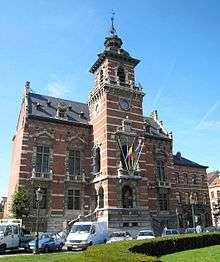
The 17th and 18th centuries were marked by the wars between the Low Countries and France. On 13 November 1792, right after the Battle of Jemappes, General Dumouriez and the French Revolutionary army routed the Austrians here once again. Among the consequences were the disbanding of the canons and Anderlecht being proclaimed an independent commune by the French.
19th century and later
The 19th century saw a remarkable population growth, mainly because of the proximity to a rapidly expanding Brussels. Remarkable new urban developments and garden cities such as La Roue/Het Rad and Moortebeek were built at the beginning of the 20th century to house the influx of newcomers. Today, the name Anderlecht rings a bell in every Belgian ear thanks to its very successful football club.
Sights
- The Collegial Church of Saint Peter and Saint Guido is still at the centre of the municipality and is located on the northern side of Place de la Vaillance, its main square. It contains the grave of the 11th century saint Guy of Anderlecht. Its Romanesque crypt dates from the 10th century and is one of the oldest in Belgium. Most of the church, however, dates from 1350 and later, with most of the currently visible architecture representing the Ogee style (15th–16th century). Construction of the tower started in 1517 but stopped with the square part up to the balcony; it was not completed until 1898.[2]
- Right next to the church, the old beguinage is home to a local historical museum.
- The Erasmus House, built in 1458, and its medicinal and philosophical gardens can be visited nearby.
- The National Museum of the Resistance, which traces the history of the Belgian resistance and German occupation of Belgium during World War II.
- The Museum of China – Scheut, which houses documents and pieces, brought back to Europe by the congregation of Scheut's missionaries, including a 15th-century bronze Buddha.
- The Maurice Carême Museum, where the Belgian poet lived and wrote.
- The Luizenmolen, a replica of an old windmill which once stood on the site.
- Anderlecht is the location of the Cureghem Cellars (French: Caves de Cureghem, Dutch: Kelders van Cureghem), a subterranean complex of handmade brick caves with Romanesque vaults, pillars, and arches, originally the site of a cattle market covered by a forged-iron roof construction in the 1890s. The cellars were simply a foundation for the upper structure until the 1930s, after which the city council decided to make better use of them. It proved more profitable to grow mushrooms in the dark and damp underground spaces for local consumption. It fell into disuse as a cattle market but, in 1984, the hall officially got listed as a Belgian monument. Due to its characteristic architecture and unique layout it was refurbished and transformed by a private company, Abattoir SA. Since 1992, it serves as an attractive and functional event site for various private, corporate or public occasions and events. One of these was the anatomic exposition 'Body Worlds' (Körperwelten) by Dr. Gunther Von Hagens which ran in the cellars between 2008 and 2009 and attracted over 500,000 visitors.
- Anderlecht also houses the Cantillon Brewery, a gueuze museum established in an actual working brewery.
- The Museum of Medicine, located on the Erasmus campus of the Université libre de Bruxelles.
- The Jean-Claude Van Damme statue located on the Boulevard Sylvain Dupuislaan, near the Westland Shopping Center.
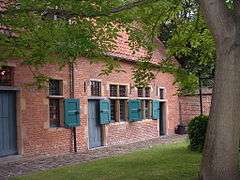 Beguinage of Anderlecht
Beguinage of Anderlecht- Moortebeek Garden City
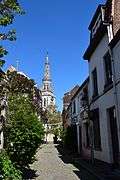 Porselein Street
Porselein Street- Justice de Paix of Anderlecht
Events
The annual Anderlecht fair, originally a cattle fair, was authorised by William II of the Netherlands in 1825. Since then, it has taken the form of a series of celebrations, which still include animal shows but also outdoors exhibitions, a floral show, and the recreation of a religious procession in honour of Saint Guido.
Economy
- The Abattoirs of Anderlecht in Cureghem is the main slaughterhouse in Brussels.
- The Delhaize Group, which operates many supermarket chains, has its head office in Anderlecht.[3]
- Coca-Cola Benelux has its headquarters in Anderlecht.[4]
- The Belgian chocolate company Leonidas has its headquarters in Anderlecht.[5]
Healthcare
Sports
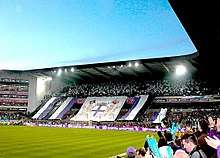
Football
Anderlecht is the home of the football club RSC Anderlecht, the most successful Belgian football team in European competition as well as in the Belgian First Division with 34 titles.[6] The club's home stadium is the Constant Vanden Stock Stadium, located within the Astrid Park. The team colors are white and purple.
Parks and green spaces
Green spaces in the commune include:[7]
- Astrid Park
- Parc Forestier/Bospark in Scheut
- Scherdemael Park
- Peterbos Park
- Joseph Lemaire Park
- Jean Vives Park
- Parc des étangs/Vijverspark in Neerpede
- Parc de la rosée/Dauwpark in Cureghem
- Vogelenzang, a natural protected area
Famous inhabitants

- Guy of Anderlecht (ca 950–1012), known as the Poor Man of Anderlecht, patron saint of Anderlecht[8]
- Adrian VI (1459–1523), pope, theologian, rector at the University of Leuven, canon at the Chapter of Anderlecht, lived in Anderlecht.
- Joseph Bracops (1900–1966), politician and mayor
- Jacques Brel, singer. He lived from 1942 to 1951 at 7, Jacques Manne Street, and worked from 1946 to 1953 in the family cartonery Vanneste & Brel (now SCA Packaging) at 18, Verheyden Street. A metro station located in the municipality is named after him.
- Maurice Carême (1899–1978), poet
- Fernand Dineur (1904–1956), cartoonist
- Desiderius Erasmus (1466–1536), humanist and theologian
- Désiré Keteleer (1920–1970), cyclist
- Filip Peeters (born 1962), Flemish actor
- Germaine Schneider (1903–1945), Belgian-Swiss resistance fighter
- Henri Seroka (born 1949), composer
- Henri Simonet (1931–1996), politician and mayor
- Jacques Simonet (1963–2007), politician and mayor
- Philippe Thys (1889–1971), cyclist and three-time champion of the Tour de France
- Tonia (born 1947), singer
- Toots Thielemans (1922–2016), jazz musician, lived in Anderlecht.
- William Vance (born 1935), comic book artist
- Constant Vanden Stock (1914–2008), entrepreneur, footballer and functionary
- Régine Zylberberg (born 1929), chanson singer, actress and nightclub entrepreneur
- Princess Elisabeth, Duchess of Brabant (born 2001), Duchess of Brabant, the oldest child of the Belgian king Philippe; heiress
- The princes Gabriel and Emmanuel and Princess Eléonore; 2nd, 3rd and 4th in line to the throne of Belgium, were born in Anderlecht.
Twin towns — sister cities
Anderlecht is twinned with:[9]





In addition, the municipality of Anderlecht has signed a friendship agreement with:[10]

References
- ↑ Population per municipality as of 1 January 2017 (XLS; 397 KB)
- ↑ Eug. De Seyn, "Geschied- en aardrijkskundig woordenboek der Belgische gemeenten" (Historic and Geographic Dictionary of Belgian communes), A. Bieleveld, Brussels 1933-1934.
- ↑ "Contacts Archived 2012-05-22 at the Wayback Machine.." Delhaize Group. Retrieved on 16 May 2012. "Square Marie Curie 40 1070 Brussels - Belgium"
- ↑ "Contact" (in French). Retrieved 2017-02-17.
- ↑ "Leonidas - Bienvenue dans un monde chocolat". www.leonidas.com. Retrieved 2017-02-17.
- ↑ "Belgium - List of Champions". www.rsssf.com. Retrieved 2017-02-17.
- ↑ Decker, Frédéric De. "Parcs publics". www.anderlecht.be. Retrieved 2016-12-29.
- ↑ Guy of Anderlecht at saints.sqpn.com. Retrieved 26.March 2013
- ↑ Decker, Frédéric De. "Projets européens". www.anderlecht.be (in French). Retrieved 2017-02-28.
- ↑ Decker, Frédéric De. "Projets européens". www.anderlecht.be (in French). Retrieved 2017-02-28.
External links
| Wikimedia Commons has media related to Anderlecht. |
- Official site of Anderlecht (only in French or Dutch)
- Mayor Jacques Simonet died


